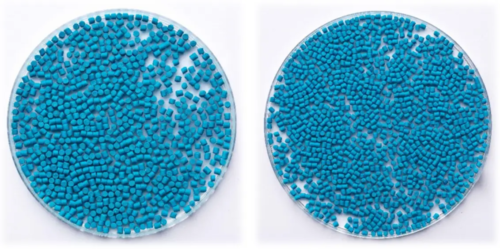Original ferric phosphate slug pellet formulation still first choice

Left: SluxxHP standard pellet. Right: Menorexx mini pellet.
This has seen several new products come to market, but the experience of two independent agronomists suggests the first ferric phosphate formulation to hit the UK market remains a top choice for performance in the field.
Christina Scarborough of CJS Agronomy oversees a wide range of crops, including cereals, oilseed rape, pulses, sugar and fodder beet, maize, field veg and flowers across Leicestershire and Notts.
With these crops predominantly on heavy clay, slugs can be a major issue in wet years, while in the higher value crops, the pest is a constant threat that can cause serious economic damage.
“It’s a real problem, particularly where oilseed rape is in the rotation, as the environment is ideal for the slugs. The veg and flowers I look after are very palatable for slugs too, so overall my growers do use significant volumes of slug pellets each season,” she explains.
Metaldehyde concerns
Like many, Christina relied on metaldehyde since methiocarb’s ban in 2015, but with concerns over its environmental profile and it regularly being found in raw water supplies, Christina has been gradually moving her clients over to ferric phosphate baits.
Its introduction has largely been done alongside metaldehyde, which is an active ingredient that gives a much faster knockdown and evidence of control on the soil surface in the form of dead slugs.
This is in contrast to ferric phosphate; which slugs ingest and then retreat underground before dying.
“It has enabled them to get used to how it works, and I think farmers are generally very happy with ferric phosphate, particularly with Sluxx HP,” adds Christina.
Made from 100% durum wheat flour, a Sluxx HP pellet is essentially pasta dough which is slow baked to minimise cracking and potential moisture ingress in the field, making it durable under wet conditions.
Its patented Ferric Field Technology formulation also contains a food-grade anti mould agent to ensure palatability to slugs and an EDDS chelating agent which ensures efficacy equally in wet and dry conditions.
Pellet durability
Christina says that compared to many metaldehyde products she has recommended in the past, which tended to break down very quickly, the opposite has been true of the latest Sluxx HP formulation which has greater durability in the field.
“You can still see the pellets on the surface long after any significant rainfall and while other pellets tend to lose their colour, making it difficult to convince clients they are still active, with Sluxx HP you don’t have that problem as much,” she adds.
With oilseed rape drilling just a few weeks away, Christina will soon begin trapping to monitor slug activity and Sluxx HP will again be the ferric phosphate bait of choice where required.
However, she also sees the value of mini pellets in certain situations and may try some Menorexx, which uses the same formulation as Sluxx HP, but is two-thirds of the size and rate for rate offers a higher baiting point density.
One adviser to gain some experience of using Menorexx in its first autumn after launch in 2019 was CCC Agronomy’s Jonny James, who covers a range of arable crops across Sussex and Kent.
High pressure
He used the mini pellets predominantly in wheat crops after oilseed rape where slug pressure was expected to be higher.
This threat was particularly acute in fields where oilseed rape volunteers were being left to thrive in stubbles as part of an experiment to try and keep cabbage stem flea beetles away from newly emerging oilseed rape plants.
“This left a lot of green trash and a perfect haven for slugs. Sluxx is tried and tested and we are confident in the quality of the formulation but wanted to try and increase the baiting points in those situations.
“We are getting about 60% more bait points/sq m with Menorexx at 5kg/ha compared to Sluxx at the same rate and it proved very effective,” explains Jonny.
Cost saving
In addition to maximising bait points in high pressure situations, Menorexx now offers an opportunity to cuts slug pellet rates, while still maintaining adequate baiting points.
Last autumn, one of Jonny’s direct drilling clients tried a 2kg/ha rate of Menorexx through a drill-mounted applicator for early protection.
“With the loss of Deter (clothianidin), there is increased potential for seed hollowing and particularly in direct drilled crops where you get a channel where slugs can move along and feed.
“Putting that low rate down the drill worked very effectively last year.”
All pellets were severely tested by last autumn’s heavy rain.
Jonny says that although Menorexx pellets aren’t as durable as Sluxx HP due to their smaller size, it generally fared better than other products he recommended and will be used again this year.
“We also had no complaints in terms of spreading, with my clients spreading it effectively at 12 or 15 metres,” he adds.
Spreadability
Work carried out by Staffordshire-based spreader and sprayer testers SCS on behalf of manufacturer Certis has backed up the product’s good spreadability, which has been a concern with metaldehyde-based mini pellets.
Tray testing using a twin disc Stocks Ag Fanjet Duo, calibrated and set up by SCS expert Rob Foxall, spread Menorexx effectively to 24m.
“You would expect that smaller and lighter pellets would not spread as uniformly to wider widths, but we were surprised to see that they spread as well as standard sized pellets in ideal conditions,” adds Rob.
For more on integrated slug control visit Slug Force.